Things You Should Know About Florence
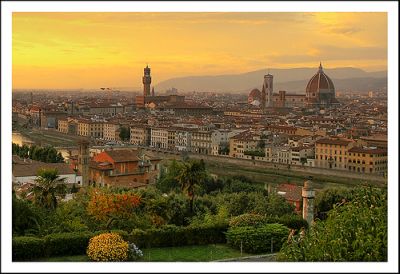 When most people think of visiting Italy for the first time, their first “must-see” destinations are what I call Italy’s “Holy Trinity” – Rome, Venice, and Florence. Of those three cities, Rome and Venice require the most preparation (in my opinion) in order to get the most out of them. Florence, by comparison, is easy.
When most people think of visiting Italy for the first time, their first “must-see” destinations are what I call Italy’s “Holy Trinity” – Rome, Venice, and Florence. Of those three cities, Rome and Venice require the most preparation (in my opinion) in order to get the most out of them. Florence, by comparison, is easy.
With a relatively compact historic center that’s still big enough to allow tourist crowds to spread out a bit, Florence is a breeze to navigate. With a reputation for good food, Florence can be counted on as a place where you’ll eat well. And with no shortage of top-notch attractions – the kind on many lifetime to-do lists – Florence leaves you with very few reasons to be bored.
Still, there are some things that it’s important to know about Florence. The city is incredibly popular with tourists, and it seems to be full year-round with visitors – either people on holiday or student groups on class field trips – so learning a little bit about how to best use your time in Florence pays dividends (especially when you get to bypass long lines).
Yes, I think Florence doesn’t require as much work in order to fall in love with the city, but that doesn’t mean it’s not also just as easy to be disappointed in Florence if you expect too much from her. So here are some of the things you should know about Florence before you go.
Florence is best explored on foot.
 The historic center of Florence is not only perfect for walking, there’s really no other way to get around it. Unlike many other cities you’ll visit in Italy, where getting to know the public transportation system greatly enhances your visit (like in Rome or Venice), in Florence you’re unlikely to need to even buy a bus ticket or learn where the buses go. (And whatever you do, do not bring a rental car into the center of the city.)
The historic center of Florence is not only perfect for walking, there’s really no other way to get around it. Unlike many other cities you’ll visit in Italy, where getting to know the public transportation system greatly enhances your visit (like in Rome or Venice), in Florence you’re unlikely to need to even buy a bus ticket or learn where the buses go. (And whatever you do, do not bring a rental car into the center of the city.)
To be sure, there are parts of Florence that are outside the historic city center, and there’s a great network of buses that runs throughout the whole city – but unless you live in Florence, or have mistakenly booked a hotel in a part of the city that’s far from the center, you won’t need to learn much about the buses at all. The only exception to this is if you don’t feel like walking up to the Piazzale Michelangelo for that postcard view of the city.
Aside from possibly taking a bus up to the Piazzale, then, make sure you’ve got comfortable walking shoes in your suitcase, because you’ll be on your feet a lot. The historic center is pretty flat, and many of the biggest sights are within a short walk from one another. In short, Florence is a joy to explore on foot. And if you book a hotel or hostel room in the historic center (there are plenty of both, many of which are reasonably-priced), you’ll have no need of any transportation other than your own two feet for the duration of your stay.
Florence is stuffed to the gills with world-class art.
 When you think about Florence, the main things that probably come to mind are the art museums – and with good reason. Museums like the Uffizi Gallery and the Accademia are world-famous and deserve a prime spot on your Florence itinerary, and even the less-visited Bargello merits some time (especially if you like sculpture). And that’s not even mentioning all the churches and other galleries and museums tucked around the city that boast lesser-known masterpieces by Michelangelo, Ghirlandaio, and Donatello (to name a few).
When you think about Florence, the main things that probably come to mind are the art museums – and with good reason. Museums like the Uffizi Gallery and the Accademia are world-famous and deserve a prime spot on your Florence itinerary, and even the less-visited Bargello merits some time (especially if you like sculpture). And that’s not even mentioning all the churches and other galleries and museums tucked around the city that boast lesser-known masterpieces by Michelangelo, Ghirlandaio, and Donatello (to name a few).
No matter how much you like art, however, you may think that no one person can absorb that many masterpieces in one visit. And you’re right. I can’t tell you how many people I’ve heard say they spent a full week in Florence and still didn’t see all the art in the city. After the big ticket items, in order to make sure you don’t suffer from art overload, you might want to incorporate some other non-art things into your itinerary – like the perfume museum or the weird museum with the wax medical models, or even just a walk along the river.
This is also a city with a proud history, wonderful food, and a fine top-flight soccer team, so if you’re really tired of the art after a few museums there are lots of other things to distract you in Florence. Just be aware that if you happen to pop into that little church on the corner because it looks interesting and the door’s open, you’ll probably end up seeing more art. It’s kind of hard to escape.
Unless you go to the Duomo. Which brings me to…
In a city crammed with art, the Duomo in Florence is kind of empty.
 Florence’s Duomo is so decorative on the outside, with its multi-colored marble facade and famous red-tiled dome, you’d be forgiven for thinking the interior was just going to blow you away with its art-tastic collection. Sadly, however, the inside of the city’s main church is fairly barren.
Florence’s Duomo is so decorative on the outside, with its multi-colored marble facade and famous red-tiled dome, you’d be forgiven for thinking the interior was just going to blow you away with its art-tastic collection. Sadly, however, the inside of the city’s main church is fairly barren.
Oh, the intricately-tiled floors are stunning, the frescoes on the interior of the dome are beautiful, and there’s no getting around the majesty of such a huge marble space. But due to a flood in late 1966, the art that once graced the Duomo’s interior is no longer in the Duomo.
Floods from the Arno River aren’t terribly uncommon, but in November 1966 the waters rose so high that some of the art in the Duomo (as well as other churches around the city) was damaged. When the water and mud were cleared, artworks were removed for repair – and then most of them ended up in the Duomo Museum nearby rather than being put back in the Duomo itself. Even those fancy doors everyone tells you to look at on the Baptistery across from the Duomo’s front doors are replicas now (the originals are also in the Duomo Museum).
So while the Duomo’s facade is much-photographed and the interior makes a lovely respite from summer heat or winter rain (and did I mention it’s free to enter?), a visit to the cathedral won’t allow you to check off one piece of art after another the way some other Florence churches and museums will.
Booking in advance to see Florence’s museums is highly, highly recommended.
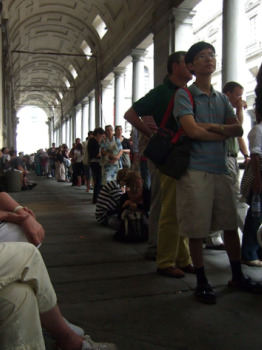 As mentioned earlier, the main things that almost everyone comes to see in Florence are the art museums. And since these museums occupy historic (read: small) buildings, museum officials limit the number of visitors that can be inside at a given time. Put these two things together – and throw in the fact that the city is always crowded with tourists – and you’ve got the makings of some very long lines.
As mentioned earlier, the main things that almost everyone comes to see in Florence are the art museums. And since these museums occupy historic (read: small) buildings, museum officials limit the number of visitors that can be inside at a given time. Put these two things together – and throw in the fact that the city is always crowded with tourists – and you’ve got the makings of some very long lines.
I’ve heard reports of people getting up at the crack of dawn and still waiting 6+ hours in line to get into the Uffizi. This doesn’t have to be your travel tale, however. You can – and should – book your tickets to Florence’s top sights in advance, either online or by phone, to make the most of your time in the city. Yes, you’ll pay a little extra for booking in advance, but if spending a few euro isn’t better than waiting 6+ hours in line, I dunno what is.
>> There’s information about booking tickets in advance on the pages I’ve written about the Uffizi and the Accademia.
If you absolutely, positively cannot handle the idea of buying your tickets in advance, there is one other alternative. It’s not a guarantee, but it’s worth a shot. There’s a semi-secret ticket window that sells last-minute tickets to things like the Uffizi and Accademia. They’re selling the tickets other people have cancelled, so you don’t have as many choices for entry times, but if you visit the ticket window early in your trip to Florence you should be able to get tickets for a time that works for you.
Florence has some of the best gelato in Italy.
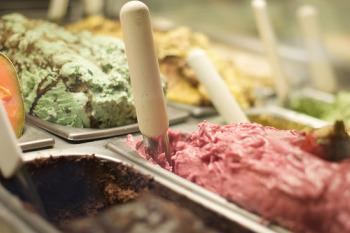 I may get flack for saying this, but if I had to choose between never getting to see the amazing art in Florence again or never eating the city’s amazing gelato again, I’d be content to look at the art in books. Florence is noted around Italy for its fantasmagorical (don’t try to look that up) gelato, and sampling it all over the city is an excellent way to pass the time.
I may get flack for saying this, but if I had to choose between never getting to see the amazing art in Florence again or never eating the city’s amazing gelato again, I’d be content to look at the art in books. Florence is noted around Italy for its fantasmagorical (don’t try to look that up) gelato, and sampling it all over the city is an excellent way to pass the time.
One of the most famous gelato shops in Italy is Vivoli, on a tiny side-street away from the main tourist thoroughfares. It’s excellent, but not my favorite. My favorite, Festival del Gelato, is actually one that’s right off the main pedestrian drag leading from the Duomo to the Piazza della Signoria.
But the thing is, there are a zillion more gelato shops in Florence that produce exquisite gelato. Some of them are less-than-wonderful, but most of the gelato I’ve tried in Florence has been worth every euro I spent on it. (Whereas in some other cities, I’ve been known to throw away sub-par gelato after a few bites.)
Do yourself a favor and get a scoop at every gelato shop you see. I mean, you shouldn’t take my word for it. And doing your own research in this department is about the most non-arty fun you can have in Florence.
Shopping in Florence means leather.
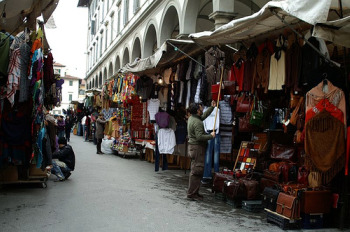 Shopping is a popular activity in Italy for both tourists and Italians. Savvy shoppers know that different regions in Italy are known for different things, and it only makes sense to buy what’s local. In Florence, that means leather.
Shopping is a popular activity in Italy for both tourists and Italians. Savvy shoppers know that different regions in Italy are known for different things, and it only makes sense to buy what’s local. In Florence, that means leather.
There are leather shops all over Florence, and two places in the historic center that transform into outdoor leather markets during the day as well. The prices are negotiable at the outdoor markets, and there are exceptional deals to be had (especially if you’re good at haggling), but these markets are also havens for pickpockets – so don’t get too mesmerized by the leather smell and forget that your purse is wide open.
If that leather smell does take over, however, don’t be surprised if you return home with a new selection of belts, purses, wallets, jackets, and shoes. And if you’re so inclined, I wear a size 38 shoe. Many thanks.
If you order a steak in Florence, you’d better have a big appetite.
 Let’s face it, as much as anyone loves pasta there comes a time when you just want something else for dinner in Italy. In Florence, you’re lucky, because one of the city’s specialties is steak. But before you get too excited about it, make sure you’ve got at least one other person in your dinner party who’s interested in sharing the steak with you – these things can feed 2-3 people.
Let’s face it, as much as anyone loves pasta there comes a time when you just want something else for dinner in Italy. In Florence, you’re lucky, because one of the city’s specialties is steak. But before you get too excited about it, make sure you’ve got at least one other person in your dinner party who’s interested in sharing the steak with you – these things can feed 2-3 people.
The Bistecca alla Fiorentina, as it’s known, is usually a T-Bone or porterhouse cut, and it’s huge. When you order a bistecca, you just order a bistecca. Technically, yes – you could order it well-done, but resist that urge. The steak you’ll be served will be rare, but that’s the way it’s meant to be – and cooking it more than that will actually reduce its flavor.
If you don’t think you can stomach a rare steak, then hang out with other people who order one so you can at least have a sample. At which point you may reconsider. And if you’re traveling solo and don’t make friends easily, some places will serve smaller bistecca portion sizes at lunch – so you could get almost the perfect bistecca experience without having to share.
The bread in Florence is salt-free.
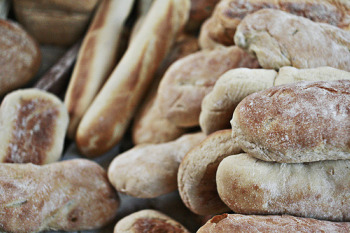 Getting a basket of bread with your dinner probably won’t be surprising, but when you bite into the bread in Florence you may sense something’s a little off. You may not know what it is, but something’s different. In fact, throughout Tuscany you would have this same experience. Something is missing – it’s the salt.
Getting a basket of bread with your dinner probably won’t be surprising, but when you bite into the bread in Florence you may sense something’s a little off. You may not know what it is, but something’s different. In fact, throughout Tuscany you would have this same experience. Something is missing – it’s the salt.
Tuscan bread is traditionally made without salt, and it’s been this way since the 12th century, according to one popular legend. That legend says that during the historical rivalry with Pisa, the Pisans thought blocking shipments of salt would force the Florentines to surrender in whatever battle they were involved with at the time. Instead, the people of Florence just made their bread without salt.
Whether that legend has any truth to it or not, the fact remains that many recipes today that incorporate Tuscan bread benefit from the bread’s lack of salt. Things like ribollita and panzanella are full of flavor, and the salt-free bread soaks up all the fantastic flavors of the dishes without competing with them.
Recipes using Tuscan bread may be great, but to non-Tuscans the bread on its own usually leaves something to be desired. In other words, impress your friends at dinner with your knowledge about why Tuscan bread is salt-free, but don’t feel bad if it’s not to your liking.
Florence is the birthplace of Stendhal Syndrome.
 You’ve heard of Stendhal Syndrome, right? Even if you haven’t heard of it by name, you’re probably familiar with it. It’s the idea that seeing so much outstanding art in rapid succession can cause someone to become lightheaded or dizzy. Well, you may be surprised to know that another name for Stendhal Syndrome is Florence Syndrome.
You’ve heard of Stendhal Syndrome, right? Even if you haven’t heard of it by name, you’re probably familiar with it. It’s the idea that seeing so much outstanding art in rapid succession can cause someone to become lightheaded or dizzy. Well, you may be surprised to know that another name for Stendhal Syndrome is Florence Syndrome.
When a French author who went by the name of Stendhal visited Florence in the early 1800s, he experienced (and wrote about) dizziness and faintness when he took in all the art. Fast-forward to the late 1970s when an Italian doctor noticed over 100 cases of the same set of symptoms of other people visiting Florence. It didn’t take long for the doctor to associate the new cases with the French author, and – voila – Stendhal Syndrome was born.
While you’re unlikely to get faint at the overwhelming displays of artwork in Florence, you may get dizzy with boredom if you’re waiting in line outside the Uffizi for hours in the midday summer sun. But you won’t be one of those people, because you read the point above about buying your tickets ahead of time, yes?
photo credits, top to bottom: stevehdc, Jessica Spiegel (& may not be used without permission), Jessica Spiegel (& may not be used without permission), kmaschke, Koze, dennis.tang, Jessica Spiegel (& may not be used without permission), McPig, fabbio, Sarah G…